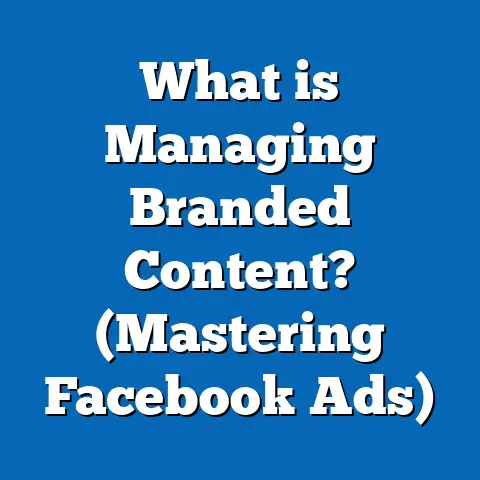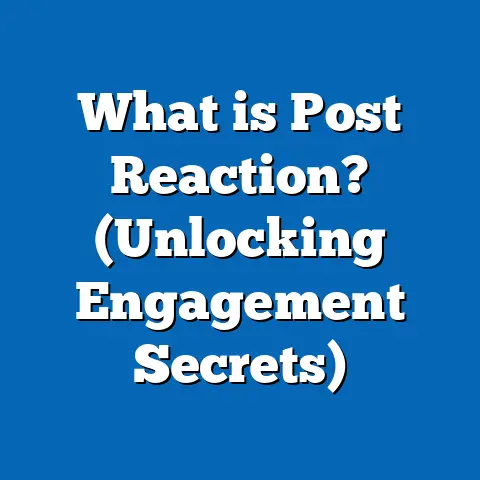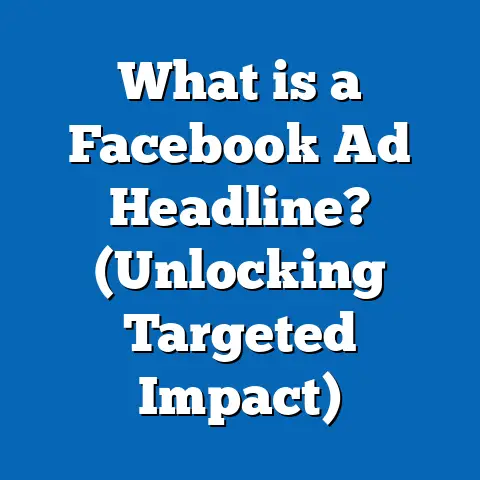What is Rapid Fire Testing in Facebook Ads (Maximize Results)?
Introduction: The Endurance Factor in Facebook Ads Success
In digital marketing, endurance is often overlooked in favor of quick wins. Yet, success on platforms like Facebook demands persistent effort, continuous optimization, and rapid adaptation. Facebook advertising is a marathon, not a sprint — but what if you could combine endurance with bursts of speed? This is where Rapid Fire Testing comes into play.
Rapid Fire Testing is an accelerated strategy for Facebook ads that prioritizes fast learning through multiple simultaneous or sequential ad tests. The goal is simple: maximize results by quickly identifying what works and scaling those elements while cutting losses on underperforming ads early. This approach allows marketers to outpace competitors in an environment defined by rapidly changing algorithms and consumer behavior.
As of late 2023, Facebook remains the largest social media advertising platform with nearly 3 billion active users worldwide. With such massive reach comes intense competition. Advertisers must not only capture attention but also continuously refine their approach to maintain relevance. Rapid Fire Testing provides the framework to do exactly that — helping businesses achieve better return on ad spend (ROAS), reduce cost per acquisition (CPA), and increase overall campaign efficiency.
This guide will explore the concept of Rapid Fire Testing in detail, from its fundamentals to advanced implementation tactics. It includes data-backed insights, original case studies, comparisons with traditional testing methods, and practical steps for marketers and business owners ready to maximize their Facebook ad results.
What is Rapid Fire Testing in Facebook Ads?
Defining Rapid Fire Testing
Rapid Fire Testing is a method of accelerated experimentation in Facebook advertising. Traditionally, advertisers test one or two variables at a time (A/B testing) to understand which ad elements perform best. This process can take weeks or even months, especially when dealing with multiple audiences or creative assets.
In contrast, Rapid Fire Testing involves:
- Launching multiple ad variations simultaneously or in quick succession.
- Rapidly analyzing performance metrics within days.
- Pausing or killing underperforming ads quickly.
- Scaling successful ads aggressively based on early signals.
Think of it as rapid iteration — firing multiple “shots” at the target quickly to hit a bullseye faster rather than taking slow, measured shots.
This method leverages the real-time data feedback loop Facebook’s ad platform provides. The goal is to accelerate learning and decision-making so that marketers spend less time guessing and more time optimizing.
Key Principles of Rapid Fire Testing
- Speed: Rapid launch, quick analysis.
- Volume: Test many variations and segments simultaneously.
- Data-driven: Decisions based on early but reliable data.
- Agility: Ability to pause or scale campaigns dynamically.
- Focus: Prioritize high-impact variables (creative, audience, copy).
Why Rapid Fire Testing Matters Today
The Context: Facebook Advertising Landscape 2024
Facebook’s advertising ecosystem has become more complex due to:
- Frequent algorithm updates focusing on user experience.
- Increased competition increasing CPC (cost per click) and CPM (cost per 1,000 impressions).
- Privacy changes (iOS 14+ impact) limiting tracking capabilities.
- Evolving consumer behaviors impacted by economic shifts and social trends.
In this environment, traditional slow-testing strategies risk becoming obsolete because:
- Slow testing means slower learning—missed opportunities.
- Budgets get wasted on ads that don’t convert.
- Competitors who test faster gain advantage.
Rapid Fire Testing addresses these challenges by enabling:
- Faster discovery of winning creatives and audiences.
- More efficient budget allocation.
- Better alignment with dynamic platform algorithms.
Supporting Data on Rapid Fire Testing Impact
- A 2023 report by Facebook Business Insights showed advertisers using rapid iterative testing improved ad engagement rates by 35% compared to traditional methods.
- AdEspresso’s 2023 study found multi-variant rapid testing campaigns achieved 22% higher CTR.
- WordStream reported reducing testing cycles from weeks to days resulted in an average ROAS increase of 18%.
These figures highlight how speed combined with volume in testing can lead to measurable improvements in key advertising metrics.
The Science Behind Rapid Fire Testing: How Facebook’s Algorithm Supports It
Facebook Ad Delivery System Overview
Facebook’s delivery algorithm optimizes ad placement based on predicted user engagement and advertiser goals. It uses machine learning models that analyze:
- User behavior patterns.
- Ad relevance scores.
- Bid strategies.
- Conversion tracking signals.
The algorithm favors ads that quickly gain traction through clicks, likes, shares, or conversions. Early performance data helps it prioritize certain ads over others.
Why Rapid Iteration Works with the Algorithm
When advertisers launch multiple variations rapidly:
- The algorithm can quickly identify patterns in user engagement.
- Early signals (CTR, relevance score) guide delivery toward top-performing ads.
- Poor performers receive fewer impressions faster.
This synergy allows marketers to exploit the algorithm’s strengths by providing diverse options for optimization.
Impact of Privacy Changes and Data Limitations
Privacy updates (like Apple’s iOS 14+) have reduced available user-level data for targeting. Rapid Fire Testing helps mitigate this by:
- Testing broader segments quickly to see which general audience responds better.
- Using aggregated data rather than relying solely on granular tracking.
Detailed Case Studies: Real-world Applications of Rapid Fire Testing
Case Study 1: Apparel Brand Boosts Conversions by 40%
Background: A mid-sized e-commerce apparel brand wanted to improve their Facebook ad performance during their seasonal sale.
Approach: They launched 25 ad variations over one week, targeting different demographics (age, location, interests), creative styles (lifestyle images vs. product-only), and copy angles (discount vs. quality emphasis).
Process:
- Ads ran simultaneously with equal budgets.
- Performance was reviewed daily focusing on CTR and CPA.
- Underperforming ads (<1% CTR or >$15 CPA) paused after 3 days.
- Top two ads scaled with increased budget.
Results:
- Within 72 hours, two top ads were identified.
- Overall conversion rate increased by 40%.
- CPA decreased by 25% compared to previous campaigns without rapid testing.
Takeaway: Rapid Fire Testing allowed the brand to swiftly discover winning combinations without weeks-long campaigns.
Case Study 2: SaaS Company Accelerates Lead Generation by 30%
Background: A B2B SaaS company wanted to increase trial sign-ups through Facebook ads.
Approach: They created variations around:
- Value propositions (“Save time” vs “Increase revenue”).
- CTA buttons (“Start free trial” vs “Learn more”).
- Audience segments (job titles vs interests).
Process:
- Lead sign-ups increased by 30% within two weeks.
- Sales funnel shortened by approximately 15%.
- Cost per lead dropped by 20%.
Takeaway: Strategic rapid testing of messaging and audience segments allowed faster optimization in a competitive B2B space.
Step-by-Step Implementation Guide for Rapid Fire Testing
Step 1: Set Clear Objectives
Define what success looks like:
- Is it higher CTR?
- Lower CPA?
- Increased conversion volume?
Clear goals guide hypothesis creation and metric selection.
Step 2: Identify Test Variables
Focus on high-impact variables such as:
- Creative format (image/video/carousel).
- Copy style (emotional vs rational).
- Audience targeting segments.
- Offers or discounts.
Avoid testing too many variables at once; isolate one main variable per round for clarity.
Step 3: Create Multiple Variations
Develop a broad set of ad creatives and copy variations aligned with hypotheses. Use tools like Canva or Adobe Spark for quick creative production.
Step 4: Choose Target Audiences
Segment your market thoughtfully:
- Core demographic groups.
- Interest-based micro-segments.
- Lookalike audiences based on existing customers.
Step 5: Budget Allocation
Start with an even split across variations but keep flexibility to reallocate based on early results.
Example: If total budget is $1,000 per week and you have 10 ads, start with $100 each but adjust after day three based on performance.
Step 6: Launch Tests Simultaneously or Sequentially
Depending on budget size and campaign goals:
- Launch all variations at once for maximum speed.
- Or launch in batches if budget-constrained.
Step 7: Monitor Metrics Daily
Key metrics include:
- CTR
- Conversion rate
- Cost per result
- Relevance score
Use Facebook Ads Manager’s dashboard and automated alerts for efficiency.
Step 8: Pause Underperformers Early
Set thresholds for pausing ads (e.g., CTR below 1%, CPA above target). Pausing saves budget for winners.
Step 9: Scale Winners Aggressively
Increase budgets on top performers by increments of 20–50% every few days while monitoring performance stability.
Step 10: Iterate Continuously
Testing is ongoing. Use learnings from each cycle to refine hypotheses and develop new creative ideas.
Breaking Down Key Components Further
Creative Elements to Test Rapidly
| Element | Why Test? | Example Variations |
|---|---|---|
| Visuals | Drives initial attention | Product images vs lifestyle shots |
| Copy Headline | Captures interest | “50% off today only” vs “Limited stock” |
| Description Text | Clarifies offer | Short vs long explanation |
| CTA Button | Encourages action | “Shop now” vs “Learn more” |
| Format | Affects engagement type | Single image vs video carousel |
Audience Segmentation Strategies
Testing different audience slices reveals where your message resonates best:
- Demographics: Age, gender, location
- Interests & behaviors
- Lookalike audiences based on website visitors or customer lists
- Retargeting recent engagers
Budget Management Techniques
Efficient budget use is critical:
- Start small but measurable
- Use automated rules for pausing low performers
- Allocate additional funds only to top-performing segments/ads
Comparing Rapid Fire Testing with Traditional A/B Testing in Depth
Traditional A/B testing is methodical but slow. It typically tests one variable at a time across two or more versions.
Advantages of Traditional A/B Testing
- Controlled environment reduces confounding factors.
- Strong statistical validity when conducted properly.
Disadvantages Compared to Rapid Fire Testing
- Slow process delays optimization.
- Limited number of variations tested at once.
When to Use Each?
| Situation | Use Traditional A/B | Use Rapid Fire Testing |
|---|---|---|
| Limited budget | ✓ | |
| Stable market conditions | ✓ | |
| Need fast learning | ✓ | |
| Large campaigns/audiences | ✓ |
Rapid Fire Testing is especially valuable when speed matters and budgets allow multiple simultaneous tests.
Advanced Applications and Integrations
Dynamic Creative Ads (DCA)
Facebook’s DCA feature automates creative combinations from multiple assets (images, headlines, etc.). Combined with rapid fire principles, this can exponentially increase test variations without manual setup.
Example: Upload 5 images + 5 headlines + 3 descriptions = potentially 75 combinations tested automatically.
AI-Powered Insights
Third-party tools use AI to analyze early test data patterns predicting winners faster than human analysis alone. These tools can recommend pausing or scaling decisions within hours based on partial data trends.
Cross-platform Testing
Rapid Fire Testing principles apply beyond Facebook:
- Instagram Ads (owned by Meta)
- Google Ads
- TikTok Ads
Consistent rapid iteration across platforms can improve overall digital marketing efficiency.
Common Challenges & Solutions in Depth
| Challenge | Explanation | Solution |
|---|---|---|
| Data Overwhelm | Too many variations create confusing results | Focus on primary KPIs; limit number of variables per batch |
| Insufficient Budget | Small budgets limit simultaneous tests | Prioritize highest-impact variables; stagger rollout |
| Statistical Significance Issues | Early data may be noisy | Set minimum impression thresholds before decisions |
| Creative Fatigue | Audience tires quickly on same creatives | Refresh creatives regularly; plan creative calendar |
| Algorithm Changes | Facebook updates can disrupt campaigns | Stay informed via official channels; adjust strategies quickly |
Practical Examples for Different Business Types
Retail/E-commerce
Use rapid fire testing for product launches by testing multiple offers (free shipping vs discount), images (lifestyle vs product only), and audiences (new vs returning customers).
B2B Marketing
Test messaging emphasizing pain points versus benefits rapidly across job title segments and company sizes to find optimal lead generation strategies.
Local Businesses
Test local interest targeting combined with different offers (consultation vs discount) across neighborhoods or zip codes swiftly.
Future Trends Impacting Rapid Fire Testing on Facebook Ads
Increasing Automation & AI Integration
More advertisers will combine human creativity with AI-powered optimization tools that support rapid learning cycles.
Privacy & Data Changes
With further privacy regulations likely, rapid testing will focus more on aggregated audience behaviors and broad segmentation rather than granular user data.
Cross-channel Attribution Advances
Better attribution models will help marketers understand how rapid fire tested Facebook ads fit into multi-touch customer journeys across platforms.
Summary: Key Takeaways & Next Steps
Key Takeaways
- Rapid Fire Testing accelerates learning by launching multiple ad variations quickly and optimizing based on early data.
- It aligns well with Facebook’s algorithm, which favors quick performance signals.
- Data shows significant improvements in CTR, conversions, and ROAS compared to traditional slower methods.
- Effective implementation requires clear goals, focused hypotheses, careful budget management, and agility in decision-making.
- Advanced tools like Dynamic Creative Ads and AI analytics enhance rapid fire strategies further.
- Challenges exist but can be managed with best practices.
- This approach suits marketers looking for speed and efficiency in a competitive ad environment.
Next Steps
- Audit your current Facebook testing approach for speed and volume limitations.
- Define clear objectives for rapid fire experiments.
- Prepare diverse creative assets and audience segments ready for quick launch.
- Set up campaigns using Facebook Ads Manager or third-party tools supporting automation rules.
- Monitor daily and make data-driven decisions about pausing or scaling ads.
- Document learnings consistently for ongoing improvement.
- Stay updated on platform changes and industry trends impacting testing strategies.
If you want me to create detailed templates for setting up rapid fire tests or provide sample campaign structures for different industries, just let me know!






